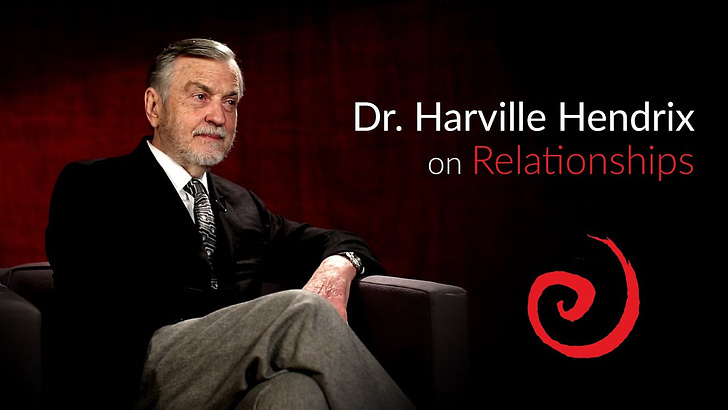Relationship chemistry, explained.
We seek partners who remind us of our trauma. Then we expect to them to heal us.
According to Harville Hendrix in Getting the Love You Want (1988), we unconsciously seek out romantic partners that remind us of the people who wounded us in childhood, because we believe only they can heal our childhood wounds.
You feel all these wonderful things called romantic love. You do not know that there is a program running in the background (of your mind) that will match you with a person with whom you will experience the worst frustrations that you had with your caretakers.
That leads then to the power struggle… .
This is the way nature works. It brings together people... for mutual healing and growth.
If I’m falling in love with somebody, I’m falling in love with the person who is going to activate the parts of me that need to grow the most.
- Dr. Harville Hendrix, describing Imago Theory
More recent books, like Playful Parenting (Cohen 2002), Trauma & Memory (Levine 2015) and The Body Keeps The Score (van der Kolk 2014), agree with Hendrix. These authors explain that one of the ways Nature programs us to heal or childhood trauma is to recreate the trauma from a position of control.
That means that our brains have been programmed by our trauma to release pleasure hormones upon discovery of the potential partner who corresponds to the childhood caretakers who hurt us. When two people experience that kind of reaction in response to one another, we say they have chemistry.
Hendrix would call this “falling in love”.

The problem with falling in love, according to Imago Theory, is that you only do it with the people who are best equipped to hurt you.
The romantic partner with whom you feel such extraordinary chemistry is exactly that person your brain has selected to recreate your trauma.
As Hendrix puts it, the love of your dreams is also your worst nightmare, as both partners attempt to gain control of the relationship for the purpose of resolving their trauma.
But it doesn’t have to be this way.
There are two pathways to surviving the mad, passionate embrace of relationship chemistry, and neither of them require blaming your partner for failing to meet your relationship needs:
1) role play, and 2) therapy.
Role play
It is possible, when aware of childhood trauma and under skilled direction, to recreate traumatic experiences in deliberate role play under the supervision of a professional qualified to help interpret these experiences. Van der Kolk devotes an entire chapter to improvisational theater to facilitate resolution of trauma by reliving it from a position of temporary, situational control. He suggests that a few hours of this method of therapy via action might be more effective than years of therapy via conversation.
Intuitively, we can see the evidence of attempts to resolve our trauma via action in unconscious elements of our own relationships, and others with whom we are intimate. For example role playing and fantasy, including BDSM sex play, may not be deliberate therapy, but they offer a theater thru which participants can explore issues of control, trauma, and resolution.
One of my confidantes was in a close relationship with a Lover who encouraged exactly this type of playful resolution for him.
“Tell me who hurt you,” she said. “Let me be her.”
“Do to me what you wanted so badly to do to her.”
Understanding this need to replay the painful scenes from our past in an effort to resolve them has helped me repair relationships in which I have injured my Love. For example, when I recognize that I’ve hurt her, I experience regret.
Sometimes, I apologize and explain what I intended to do.
Then, I describe what I would do differently, if I had the chance. I create a screenplay of the actions I wish I had taken, and the words I wish I had said, that is informed by my improved knowledge of her feelings.
Offering this type of apology allows her to relive the experience in her imagination—like a child’s “do over”—and resolve the hurt.
Therapy
According to Complex PTSD (Walker 2013) healing must take place in relationships, and for those with trauma, obstacles to healthy relationships abound—especially with imago partners selected for patterns of abuse or abandonment.
Those with Complex PTSD-spawned attachment disorders never learn the communication skills that engender closeness and a sense of belonging. When it comes to relating, they are typically plagued by debilitating social anxiety, and social phobia when they are at the severe end of the continuum of PTSD.
Many of the clients who come through my door have never had a safe enough relationship. Repetition compulsion has compelled them to unconsciously seek out relationships in adulthood that traumatically reenact the abusive and/or abandoning dynamics of their childhood caretakers.
— Pete Walker, ‘Relational Healing in Complex PTSD’
In other words, your relationships may reveal your childhood trauma without providing a vehicle for resolving it.
For example, when you’re partnered with a narcissist, or a sadist, or a sociopath, it’s important to create distance even when you can’t go full no contact. That person will never be a suitable participant in your role play, and you will need different healthy relationships in which to resolve your trauma.
When you are partnered with a Lover who is incapable of the type of role play necessary to resolve trauma from a position of control, it’s helpful to have access to other therapeutic modalities that might resolve your trauma without resorting to controlling your partner.
Rachel Reiland’s autobiographical account of her recovery from borderline personality disorder (Get Me Out of Here, 2004) describes the way she projected her imago onto her husband, casting him in the role of the villain who was persecuting her. In truth, she married a loving and supportive man who had no interest in contributing to the cognitive distortions that characterized her disorder.
While Reiland’s marriage helped her and her therapist identify her trauma, it was only through therapy that she acknowledged its origins, and came to understand how her experiences had programmed her brain to project, react, and lash out. By her own account, Reiland experienced an healing, emotionally intimate relationship her therapist, and gave up the need to control her husband.
Although Reiland’s success with talk therapy is rare, what role play and therapy have in common is storytelling. In the case of role play, the story is acted out. In the case of therapy, the story is talked out. Engaging the storytelling mind helps make sense out of our experiences and detach the memories of stressful experiences from the strong emotions that make them traumatic.
Both Walker and Levine sometimes combine the two modalities in their work as therapists. The danger in each is that the subject will relive the trauma without a resolution, causing further damage to their psyche.
For the purpose of this article, it is sufficient to understand that we are hard-wired by our biology to seek that re-enactment with our romantic partners, and why we have such great “chemistry” with the people who can hurt us the most.
Do not attempt to reenact your own trauma — in action or in conversation — without the guidance of skilled therapist who understands the power of the reenactment.

I shudder to think of all the ways that I may have traumatized my own children, and the relationships they may unconsciously be seeking to release themselves from the negative emotions of that trauma. I want to believe that my children were neither neglected nor abused — so what trauma could they possibly be expected to relive?
Nonetheless, all children experience negative emotions. The process of human development necessitates that children experience boundaries, frustrations, constraints, failures, disappointments, and grief. Those don’t necessarily equate with trauma, even under the broadest understanding of the term.
What’s most important for my grown children to consider (other than all the ways that I have injured them) is that they will encounter romantic prospects that have experienced trauma, and those partners are likely to be projecting an injurious imago. When my children encounter these traumatized individuals and are subject to their abuse and manipulations, they will be advised by their friends and counselors to avoid those romantic prospects like a life-threatening infectious disease.
That’s not been my approach in my relationships with the people whom I most admire, and for whom I most care, and whom I most ardently seek to Love.
Instead, I might use a script like this:
“There is no relationship between us until you discover what that trauma is, and make a commitment to work on resolving it.
“When that happens, I want you to know that I’m here for you.”


